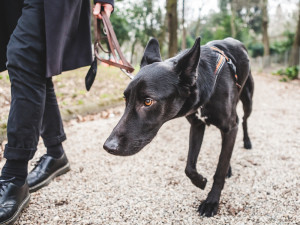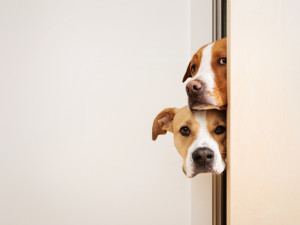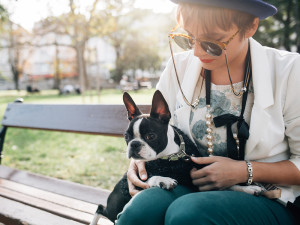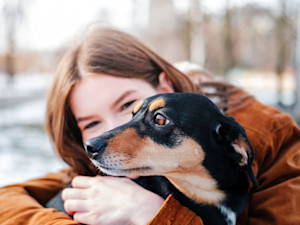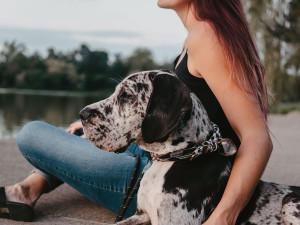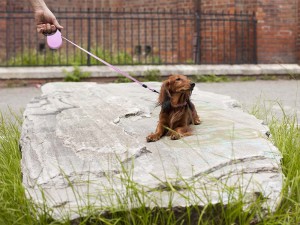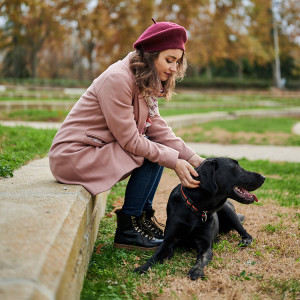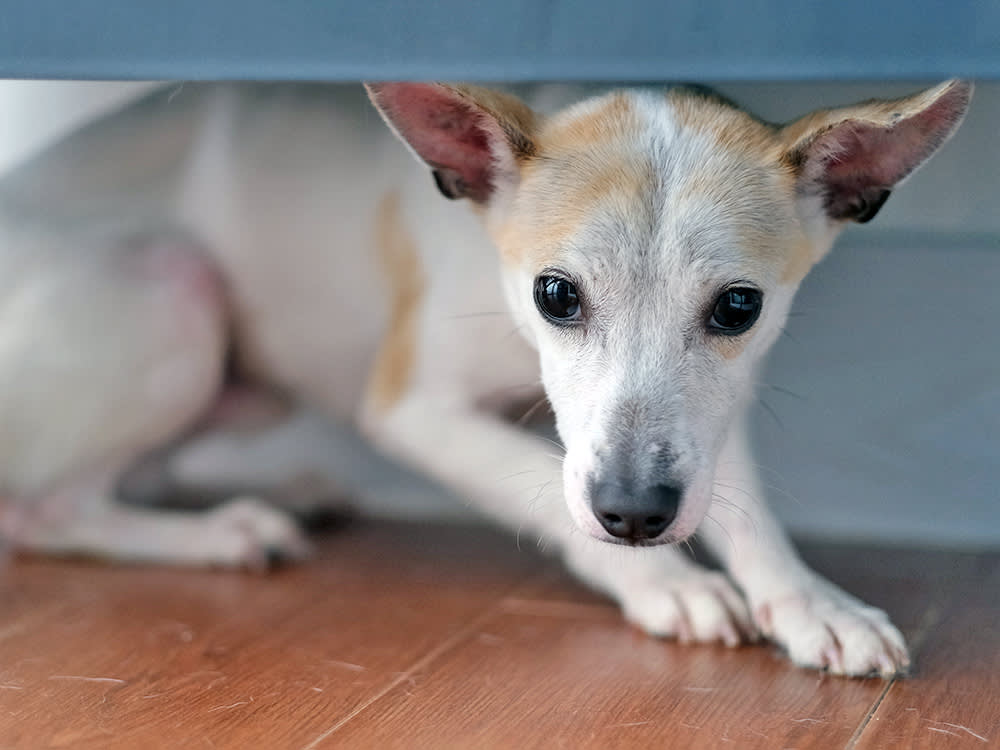
Share Article
In This Article:
How to Help Dog Who’s Scared of Thunder Why Are Dogs Scared of Thunderstorms? How to Ease Your Dog’s Fear of Thunder Other Tips or Tricks That Can Help Your Dog with a Thunder Fear Frequently Asked Questions
Does your dog shake, pace, or hide under the bed when a crack of thunder rattles your home’s windows? Many pet parents struggle to comfort their dogs when storms roll in, and the fear can be stressful for everyone in the house.
Thunderstorm anxiety is a real, terrifying phobia in dogs. But why does it happen? How can you help ease your dog’s anxiety and distress? Patience, preparation, and strategic care can turn stormy nights into calmer experiences for your pup.
How much do you spend on your pet per year?

Dog scared of thunder? Here’s what you can do
You’re not powerless when thunder sends your dog into panic mode. Preparing your home, offering comfort, and developing calming routines and techniques can reduce your dog’s stress.
Every pup responds differently. So, it may take trial and error to find what works to calm your dog’s thunderstorm anxiety. The goal isn’t to eliminate the noise, but to make storms less overwhelming. You want your dog to acknowledge the environment without feeling scared of it.
Why are dogs scared of thunderstorms?
Dogs have stronger senses than humans, so booming sounds to us are several times louder and more startling to dogs. However, the noise alone isn’t the problem. Storms have a mix of triggers that combine into one frightening experience, especially for sensitive pups.
Loud, unpredictable noise: Thunder can scare the calmest dogs because the sound is sudden.
Vibrations and pressure changes: Dogs sense barometric pressure shifts and vibrations that humans barely notice, leading to restless nights before a storm.
Static electricity in the air: Some dogs feel the buildup of electricity in their fur, causing mild shocks and zings that add to storm anxiety.
Past experiences: If a dog is caught outside in a storm or remembers being startled as a puppy, they may carry fear into adulthood.
For many dogs, these triggers overlap, creating sensory overload when the forecast turns cloudy.
How to ease your dog’s fear of thunder
Give them a safe space.
Set up a cozy retreat where your dog can feel secure during storms. This could be a crate covered with a blanket, a corner of your bedroom, or even a small bathroom if they prefer enclosed spaces. The key is to let your dog choose the spot where they feel safe and to make it accessible whenever storms approach.
Provide background noise.
White noise, fans, or calming music can help mask the sound of thunder. Some pet parents find success with playlists specifically for dogs, which use soothing tones to reduce stress. The constant sound creates a buffer that softens the jarring cracks of thunder.
Soothe them with toys, treats, and rewards.
Chewing and licking can help dogs self-soothe, so offering a durable chew toy or a stuffed food puzzle can keep their focus away from the storm. Positive reinforcement also matters. Reward calm behavior with treats or praise, so your dog begins to associate thunder with good experiences rather than fear.
Use calming aids and other products.
There are several tools available to help reduce thunder anxiety:
Thunder shirts or calming wraps apply gentle, constant pressure that many dogs find reassuring.
Pheromone diffusers or sprays mimic the scent of a nursing mother, signaling safety and comfort.
Calming supplements made with ingredients like L-theanine, chamomile, or melatonin may take the edge off for some dogs. Always check with your veterinarian before starting supplements.
For severe anxiety, a veterinarian may prescribe medication to help your dog cope during storms. This is especially important if their fear escalates to destructive or harmful behavior.
Other tips or tricks that can help your dog with a thunder fear
Thunderstorm anxiety doesn’t always fade with the basics, and some dogs need extra support to feel secure. Beyond safe spaces and calming products, a few practical strategies can make a real difference.
These additional tips focus on how you respond, how you prepare, and how you shape your dog’s associations with thunder so fear gradually gives way to confidence.
Stay calm yourself: Dogs pick up on human emotions. If you tense up, pace, or show nervousness during a storm, your dog may interpret your behavior as confirmation that something is wrong. Even if you mean well by fussing over them, that heightened attention can reinforce the idea that thunder is dangerous. Instead, keep your voice steady, move around as you usually would, and project a sense of calm.
Practice desensitization: Playing recordings of thunder at a low volume during playtime or meals can help your dog gradually adjust. Slowly increase the volume over weeks, always keeping it at a level where your dog stays calm.
Try counter-conditioning: Dr. Debra Howitz, a veterinarian and behavior consultant in St. Louis, notes, “The ideal way to treat fireworks and thunderstorm phobias is to train your dog using behavior modification techniques.” For example, pair thunder noises with something your dog loves, like treats or play, so they learn to associate the sound with positivity instead of fear.
Avoid punishment: Scolding or forcing your dog to “get over it” will only deepen their anxiety and damage their trust in you. Dogs don’t misbehave out of choice when they’re scared; they’re reacting to fear they can’t control. Yelling, pulling on the leash, or shutting them away teaches them that storms bring both loud noises and negative interactions with their pet parent. Instead of punishment, focus on calm reassurance, gentle redirection, and positive reinforcement.
Plan: Check the forecast during stormy seasons. If storms are coming, give your dog extra exercise beforehand to burn off nervous energy.
Bottom line
Thunderstorm fears are common in dogs, but with preparation and consistent support, you can make storms far less stressful.
From safe spaces and sound masking to calming products and professional help, there are plenty of tools at your disposal. The most important thing is to meet your dog’s needs with patience and reassurance. Over time, you’ll both feel more at ease when thunder rolls.
FAQs
What dog breeds are scared of thunder?
Any dog can be fearful of storms, but herding breeds like Border Collies, Australian Shepherds, and German Shepherds are often more sensitive. Smaller breeds such as Chihuahuas can also be prone to storm anxiety. Breed tendencies play a role, but individual personality and past experiences matter most.
Can dogs be trained not to be afraid of thunder?
Yes, training techniques like desensitization and counter-conditioning can reduce fear. These methods work best when started gradually and combined with positive reinforcement. Severe cases may still need extra support from calming products or veterinary care.
Should I consult a veterinarian if my dog’s fear of thunder is severe?
Absolutely. If your dog panics to the point of hurting themselves, destroying property, or refusing to eat or rest, a veterinarian can recommend medications or behavior therapy. Professional guidance ensures your dog gets the best possible care.
References
“Fear of Fireworks and Thunderstorms.” Cornell University College of Veterinary Medicine, 2025, www.vet.cornell.edu/departments-centers-and-institutes/riney-canine-health-center/canine-health-information/fear-fireworks-and-thunderstormsopens in new tab. Accessed 30 Sept. 2025.
“Fear of Thunderstorms & Fireworks.” Ryan Veterinary Hospital, University of Pennsylvania School of Veterinary Medicine. www.vet.upenn.edu/wp-content/uploads/2024/12/fear-of-thunderstorms-amp-fireworks-pdf.pdfopens in new tab.
Horwitz, Debra F., Veterinary Behavior Consultant. St. Louis, MO.

Valerie Mellema
Valerie Mellema has a Bachelor of Science in Agribusiness and Equine Industry from West Texas A&M University. She has been a professional writer for the past 20 years, covering a wide variety of pet health and care topics before founding a nonprofit focused on mental health in children and thoroughbred aftercare. She has four Border Collies and eight retired racehorses.
Related articles
![Stylish woman sitting on a bench with her Boston Terrier dog.]()
Here’s Why Your Dog Is Terrified of New People
And how to change this.
![A shy looking dog sitting on a couch.]()
Some Dogs Are Scaredy Cats — And That’s OK
Not all fearful dogs have been mistreated.
![Woman holding her scared dog outside.]()
5 Surprising Things That Dogs Are Afraid Of
And what to do when they go careening away from the Roomba.
![A woman sitting with her arm around a dog enjoying a view of water.]()
How to Cure Your Dog’s Case of the Everyday Scaries
There’s nothing to fear but fear itself — and a dog who won’t stop shaking when it thunders.
![Dachshund dog freezing on a rock during a walk]()
Why Does My Dog Turn Into a Statue on Walks?
Suddenly, your neighborhood sidewalk has some new installation art: your frozen dog.
![Woman wearing a magenta beret hat and a pink coat sitting on a wall outside and petting her black Labrador dog laying on the ground]()
How to Interpret Your Dog’s Facial Expressions and Behavior
Managing expectations about your dog’s behavior makes for a good relationship
